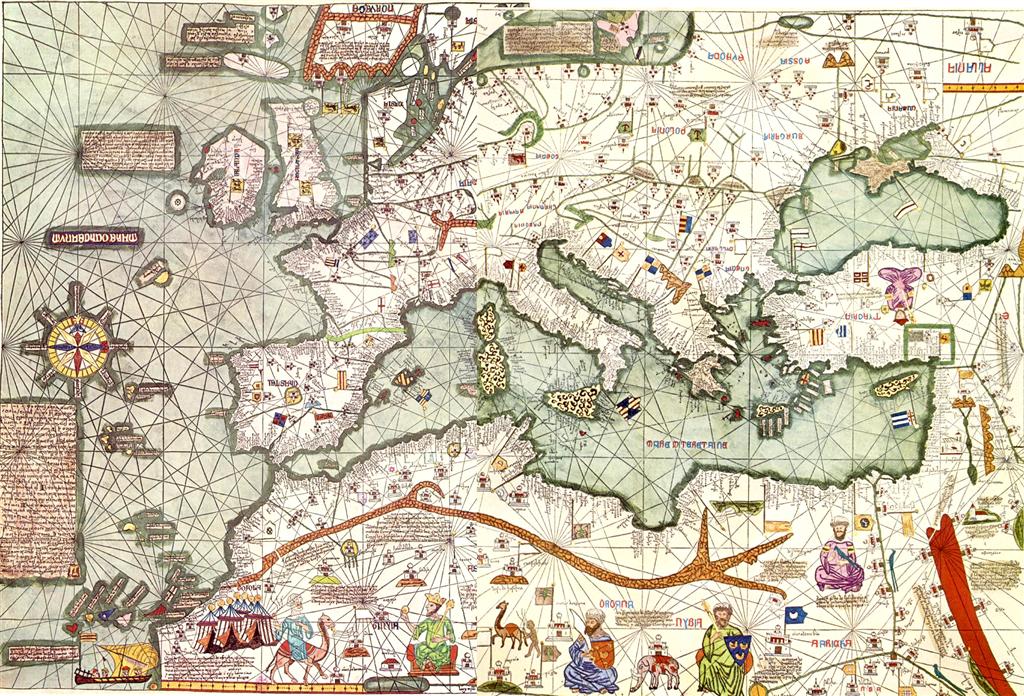1. Lingua Francas
Para saber más
Other languages have attained a global status at one time or another in history and there are many other lingua francas centralized on particular regions. These include Latin, Spanish, French, Chinese and Swahili. Before you continue reading, discuss possible reasons why these languages were used as lingua francas at a certain time or place.
 |
| Image by unknown author in Wikicommons. Public Domain |

Latin was the lingua franca of its time, although it was only ever a minority language within the Roman Empire as a whole. Crucially, though, it was the language of the powerful leaders and administrators and of the Roman military - and, later, of the ecclesiastical power of the Roman Catholic Church - and this is what drove its rise to global language status.
With the growth of the Spanish Empire, Spanish became established in the Americas, as well as in parts of Africa, Asia and Oceania. It became the language of global trade until the Napoleonic Wars and the breakup of the Spanish Empire at the beginning of the 19th century. Spanish was used as lingua franca throughout the former Spanish Colonial Empire, including territory in present day U.S., but particularly in present-day Mexico, Spanish Caribbean, Central America and South America, and it's still a lingua franca within Hispanic America.
French was already a dominant language amongst the higher ranks of society in large parts of Europe even before the 17th century. For instance in England, French was spoken amongst the aristocracy since the 11th century and the Norman conquest. French was also important in intellectual circles from the medieval period onwards. The use of French became even more prominent in the 18th and 19th century when France became a leading nation from a political, intellectual and economical point of view. French was the language of diplomacy from the 17th century until the mid-20th century.
Until the early 20th century, Classical Chinese served as both the written lingua franca and the diplomatic language in Far East Asia. In the early 20th century, vernacular written Chinese replaced Classical Chinese within China as both the written and spoken lingua franca for speakers of different Chinese dialects, and because of the falling power and cultural influence of China in East Asia, English has since replaced Classical Chinese as the lingua franca in East Asia.
Swahili is used throughout large parts of East Africa and the eastern Democratic Republic of the Congo as a lingua franca, despite being the mother tongue of a relatively small ethnic group on the East African coast and nearby islands in the Indian Ocean. At least as early as the late 18th century, Swahili was used along trading and slave routes that extended west across Lake Tanganyika and into the present-day Democratic Republic of Congo. Swahili rose in prominence throughout the colonial era, and has become the predominant African language of Tanzania and Kenya. Some ethnic groups now speak Swahili more often than their mother tongues, and many, especially in urban areas, choose to raise their children with Swahili as their first language, leading to the possibility that several smaller East African languages will fade away as Swahili transitions from being a regional lingua franca to a regional first language.
Adapted from: List of Lingua Francas. (n.d.). Retrieved January 12, 2019, from https://en.wikipedia.org/wiki/List_of_lingua_francas and The History of English - English as a Global Language. (n.d.). Retrieved June 25, 2021, from https://www.thehistoryofenglish.com/issues_global.html
Curiosidad
After the Norman conquest of Britain, the English language wound up with two words for a lot of things: one was the old, Anglo-Saxon-derived word, and the other was the new Norman French one.
In terms of food and animals for example, the Anglo-Saxon word referred to the animal while alive. The Anglo-Saxons retained their language and tended to the 'cows' and 'sheep.' The Norman words all pertained to the food as it would be eaten. The new aristocrats ate their 'beef' and 'mutton' and continued speaking Norman French.
The Normans became cut off from France eventually, and the languages fused. However, the feeling was retained - and it persists today - that Norman French terms are more sophisticated while Germanic terms are more common. This makes sense, as the Normans were the conquerors.
Rellenar huecos

Match the Anglo-Saxon origin words with their old French variations. Write the number.
Curiosidad
The legendary outlaw Robin Hood is an Anglo-Saxon nobleman suffering under the Norman yoke during the reign of King John. The subject of ballads, books and films, he has proven to be one of popular culture’s most enduring folk heroes. Over the course of 700 years, the outlaw from Nottinghamshire who robs from the rich to give to the poor has emerged as one of the most enduring folk heroes in popular culture. But how has the legend of Sherwood Forest’s merry outlaws evolved over time, and did a real Robin Hood inspire these classic tales?
Video by What Do You Know? on Youtube

Have you watched the recent Robin Hood movie starring Taron Egerton? What did you think of it? How many versions of Robin Hood have you watched? There are modern and old versions. Do you prefer the modern ones or the black and white classic ones? Which actor played the best Robin Hood?
Share your views with your partners.